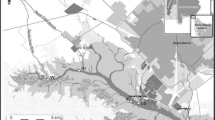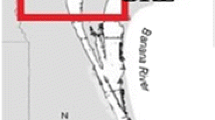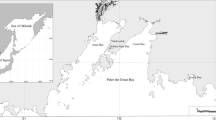Abstract
Electrochemical quantitation of metallothionin-like proteins (MLP) in mussels was based on the determination of their constituent cysteinyl residues according to Brdička's catalytic reaction. Calibration was performed by an internal MLP standard isolated from the digestive gland of Mytilus galloprovincialis for which protein concentration had been estimated by Bradford's spectrophotometric method. For that purpose three metal-binding proteins [MLP-I, MLP-II and Cu-BP (binding protein)] were separated by DEAE-Sephadex A-25 chromatography from the digestive gland of mussels previously exposed to Cd. The most negatively changed MLP-II fraction was characterized by the fact that it contained the largest amount of both total metal and sulphydryl (-SH) content per mass of protein, although this was approximately two times lower than the-SH level of commercially available MT from rabbit liver. Exposure of mussels to a relatively low level of cadmium (0.2 μg Cd l-1) added into the seawater either by itself or as a mixture with other metals (2 μg Cu l-1 and 1.6 μg Pb l-1) resulted in a measurable level of MLP induction within 14 d in comparison to the control specimens. The effect of the metal mixture on MLP synthesis appears to be less than additive, suggesting a competitive interaction between metal ions for uptake and binding sites as well as differing potentials for MLP induction. Variations in the MLP content observed in the digestive gland of mussels seasonally collected from the same location are in the range 2.1±0.4 mg g-1 on a wet weight basis. The methodological and conceptual aspects of the application of MLP induction in the Mytilus sp. as a biomarker in seawater trace metal monitoring are critically evaluated.
Similar content being viewed by others
Literature cited
Bebianno, M. J., Langston, W. J. (1991). Metallothionein induction in Mytilus edulis exposed to cadmium. Mar. Biol. 108: 91–96
Bradford, M. M. (1976). A rapid and sensitive method for the quantitation of microgram quantities of protein utilizing the principle of protein-dye binding. Analyt. Biochem. 72: 248–254
Brady, F. O. (1982). The physiological function of metallothionein. Trends biochem. Sciences 7: 143–145
Brdička, R. (1933). Polarographic studies with dropping mercury katode. Part XXXI. A new test for proteins in the presence of cobalt salts in ammonical solutions of ammonium chloride. Colln Czech. Chem. Comn 5: 112–128
Coimbra, J., Carraca, S. (1990). Accumulation of Fe, Zn, Cu and Cd during the different stages of the reproductive cycle in Mytilus edulis. Comp. Biochem. Physiol. 95C: 265–270
Chen, R. W., Ganther, H. E. (1975). Relative cadmium binding capacity of metallothionein and other cytosolic fractions in various tissues of the rat. Envir. Physiol. Biochem. 5: 378–388
Cherian, M. G. (1988). An evaluation of methods of estimation of metallothionein. In. Stoeppler, M., Piscator, M. (eds.) Cadmium. Springer-Verlag, Berlin, p. 227–237
Frazier, J. M. (1979). Bioaccumulation of cadmium in marine organisms. Envir. Hlth Perspectives 28: 75–79
Frazier, J. M., George, S. G., Overnell, J., Coombs, T. L., Kägi, J. H. R. (1985). Characterization of two molecular weight classes of cadmium binding proteins from the mussel, Mytilus edulis L. Comp. Biochem. Physiol. 80C: 257–262
George, S. G. (1991). Biochemical and cytological assessments of metal toxicity in marine animals. In: Furness, R. W., Rainbow, P. S. (eds.) Heavy metals in the marine environment. CRC Press, Boca Raton, Florida, p. 124–142
Harrison, F. L., Lam, J. R., Berger, R. (1983). Sublethal responses of Mytilus edulis to increased dissolved copper. Sci. total Envir. 28: 141–158
Hemelraad, J., Kleinveld, H. A., de Roos, A. M., Holwerda, D. A., Zandee, D. I. (1987). Cadmium kinetics in freshwater clams. III. Effect of zinc on uptake and distribution of cadmium in Anodonta cygnea. Archs envir. Contam Toxic. 16: 95–101
Jackim, E., Morrison, G., Steele, R. (1977). Effects of environmental factors on radiocadmium uptake by four species of marine bivalves. Mar. Biol. 40: 303–308
Kägi, J. H. R., Vallee, B. L. (1960). Metallothionein: a cadmium-and zinc-containing protein from equine renal cortex. J. biol. Chem. 235: 3460–3465
Kägi, J. H. R., Vašak, M., Lerch, K., Gilg, D. E. O., Hunziker, P., Bernhard, W. R., Good, M. (1984). Structure of mammalian metallothionein. Envir. Hlth Perspectives 54: 93–103
Kaitala, S. (1988). Multiple toxicity and accumulation of heavy metals in two bivalve mollusc species. Wat. Sci. Tech. 20: 23–32
Lobel, P. B., Payne, J. E. (1984). An evaluation of mercury-203 for assessing the induction of metallothionein-like proteins in mussels exposed to cadmium. Bull. envir. Contam. Toxic. 33: 144–152
Lobel, P. B., Payne, J. F. (1987). The mercury-203 method for evaluating metallothioneins: interference by copper, mercury, oxygen, silver and selenium. Comp. Biochem. Physiol. 86C: 37–39
Mackay, E. A., Overnell, J., Dunbar, B., Hunziker, P. E., Kägi, J. H. R., Fothergill, J. R. Complete amino acid sequences of five dimeric and four monomeric forms of metallothionein from the edible mussel, Mytilus edulis. (in preparation)
Margoshes, M., Vallee, B. L. (1957). A cadmium protein from equine kidney cortex. J. Am. chem. Soc. 79: 4813
Martinčić, D., Kwokal, Ž., Peharec, Ž., Marguš, D., Branica, M. (1992). Distribution of Zn, Pb, Cd and Cu between seawater and transplanted mussels (Mytilus galloprovincialis). Sci. total Envir. 119: 211–230
Müller, O. H. (1963). Polarographic analysis of proteins, amino acids and other compounds by means of the Brdička reaction. In: Glick, D. (ed.) Methods of biochemical analysis XI. Interscience Publishers, J. Wiley and Sons, New York, p. 329–403
Olafson, R. W., Sim, R. G. (1979). An electrochemical approach to quantification and characterization of metallothioneins. Analyt. Biochem. 100: 343–351
Olafson, R. W., Sim, R. G., Boto, K. G. (1979). Isolation and chemical characterization of the heavy metal-binding protein metallothionein from marine invertebrates. Comp. Biochem. Physiol. 62B: 406–416
Onosaka, S., Cherian, M. G. (1982). Comparison of metallothionein determination by polarographic and cadmium-saturation methods. Toxic. appl. Pharmac. 63: 270–274
Onosaka, S., Tanaka, K., Doi, M., Okahara, K. (1978). A simplified procedure for determination of metallothionein in animal tissues. Eisei Kagaku 24: 128–133
Paleček, E., Pechan, Z. (1971). Estimation of nanogram quantities of proteins by pulse polarographic techniques. Analyt. Biochem. 42: 59–71
Pavičić, J., Balestreri, E., Lenzi, F., Raspor, B., Branica, M., Felicioli, R. (1991). Isolation and partial characterization of Cd-induced metallothionein-like proteins in Mytilus galloprovincialis. Mar. Chem. 36: 249–265
Pavičić, J., Škreblin, M., Kregar, I., Tušek-Žnidarič, M., Stegnar, P. (1985). Formation of inducible Cd-binding proteins similar to metallothioneins in selected organs and life stages of Mytilus galloprovincialis. J. Etud. Pollut. CIESM 7 (1984):699–705
Pavičić, J., Škreblin, M., Kregar, I., Tušek-Žnidarič, M., Stegnar, P. (1989). Determination of Cd-binding proteins similar to metallothionein in the digestive gland of Mytilus galloprovincialis in relation to the preliminary treatment of the sample. Period. Biol. 91: 213–224
Pavičić, J., Škreblin, M., Raspor, B., Tušek-Žnidarič, M., Kregar, I., Stegnar, P., Branica, M., (1987). Metal pollution assessment of the marine environment by determination of metal-binding proteins in mytilus sp. Mar. Chem. 22: 235–248
Phillips, D. J. H. (1976). The common mussel Mytilus edulis as an indicator of pollution by zinc, cadmium, lead and copper. I. Effects of environmental variables on uptake of metals. Mar. Biol. 38: 59–69
Pietrowski, J. K., Bolanowska, W., Sapota, A. (1973). Evaluation of metallothionein content in animal tissues. Acta biochim. pol. 20: 207–215
Raspor, B., Pavičić, J. (1991). Induction of metallothionein-like proteins in the digestive gland of Mytilus galloprovincialis after a chronic exposure to the mixture of trace heavy metals. Chem. Spec. Bioavail. 3: 39–46
Raspor, B., Pavičić, J., Branica, M. (1987) Possible biological reference material for environmental control analyses — cadmium induced proteins from Mytilus galloprovincialis. Fresenius Z. Anal. Chem. 326: 719–722
Roesijadi, G. (1981). The significance of low molecular weight, metallothionein-like proteins in marine invertebrates: current status. Mar. envirl Res. 4: 167–179
Roesijadi, G. (1986). Mercury-binding proteins from the marine mussel, Mytilus edulis. Envir. Hlth Perspectives 65: 45–48
Roesijadi, G., Morris, J. E. (1988). Enzyme-linked immunosorbent assay for metal-binding proteins of Mytilus edulis. In: Yentsch, C. M., Mague, F. C., Horan, P. K. (eds). Immunochemical approaches to coastal, estuarine and oceanographic questions. Springer-Verlag, Berlin, p. 283–290
Scheuhammer, A. M., Cherian, M. G. (1986). Quantification of metallothionein by silver-saturation method. Toxi. appl. Pharmac. 82: 417–425
Stone, H., Overnell, J. (1985). Non-metallothionein cadmium binding proteins. Comp. Biochem. Physiol. 80C: 9–14
Talbot, V. W., Magee, R. J. (1978). Naturally-occurring heavy metal binding proteins in invertebrates. Archs envir. Contam. Toxic. 7: 73–81
Suzuki, K. T., Maitani, T. (1981). Metal-dependent properties of metallothionein. Biochem. J. 199: 289–295
Templeton, D. M., Cherian, M. G. (1984). Chemical modifications of metallothionein. Preparation and characterization of polymers. Biochem. J. 221: 569–575
Thompson, J. A. J., Cosson, R. (1984). An improved electrochemical method for the quantification of metallothioneins in marine organisms. Mar. envirl Res. 11: 137–152
Viarengo, A., Pertica, M., Mancinelli, G., Zanicchi, G., Bouquegneau, J. M., Orunesu, M. (1984). Biochemical characterization of copper-thioneins isolated from the tissues of mussels exposed to the metal. Molec. Physiol. 5: 41–52
Viarengo, A., Pertica, M., Mancinelli, G., Zanicchi, G., Orunesu, M. (1980). Rapid induction of copper-binding proteins in the gills of metal exposed mussels. Comp. Biochem. Physiol. 63C: 215–218
Weser, U., Rupp, H. (1979). Physico chemical properties of metallothioneins. In: Webb, M. (ed.), The chemistry, biochemistry and biology of cadmium. Elsevier/North Holland Biomedical, Amsterdam, p. 267–283
Wong, V. W. T., Rainbow, P. S., (1985). Estimation of crab metallothioneins using a modified Lowry assay. Comp. Biochem. Physiol. 81C: 303–305
Yoshikawa, H., Ohta, H. (1982). Interaction of metals and metallothionein. In: Foulkes, E. C. (ed) Biological roles of metallothionein. Elsevier/North Holland, Amsterdam, p. 11–25
Author information
Authors and Affiliations
Additional information
Communicated by O. Kinne, Oldendorf/Luhe
Rights and permissions
About this article
Cite this article
Pavičić, J., Raspor, B. & Martinčić, D. Quantitative determination of metallothionein-like proteins in mussels. Methodological approach and field evaluation. Marine Biology 115, 435–444 (1993). https://doi.org/10.1007/BF00349842
Received:
Accepted:
Issue Date:
DOI: https://doi.org/10.1007/BF00349842




